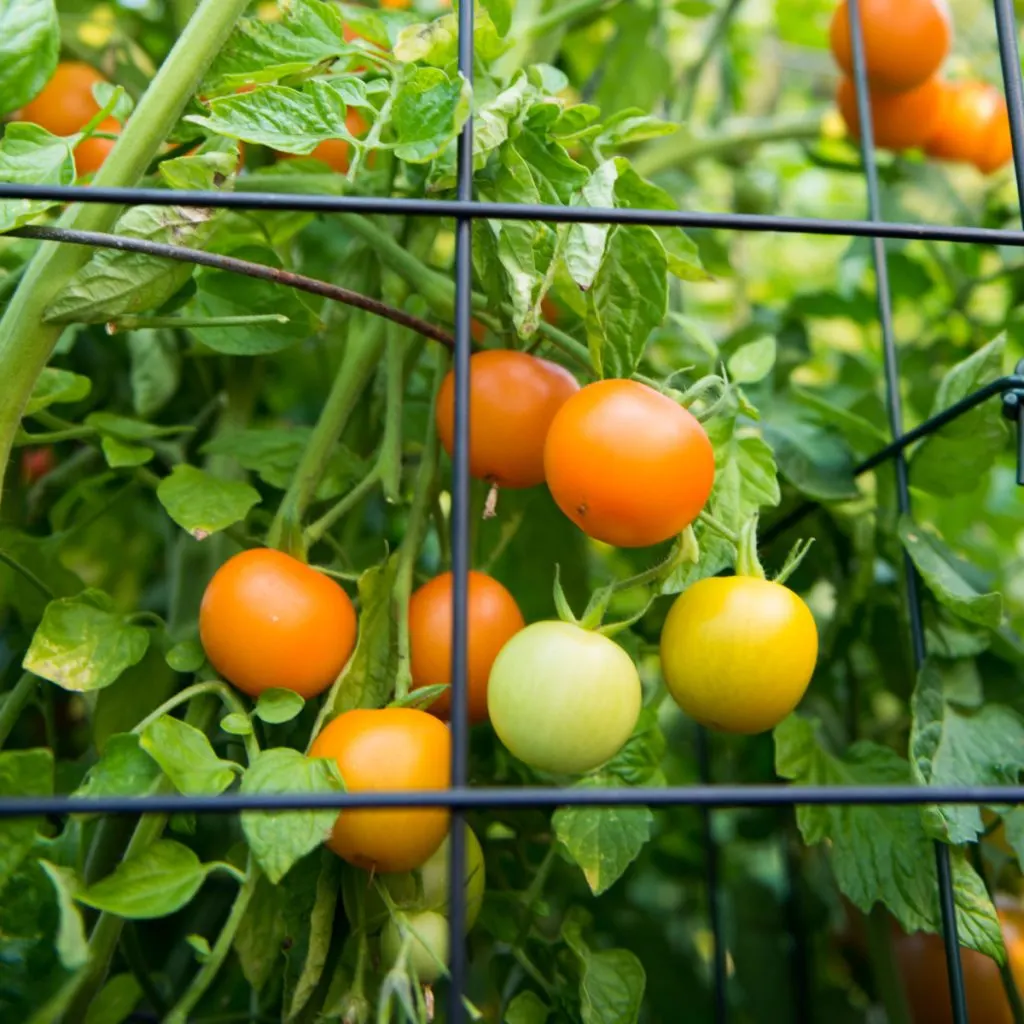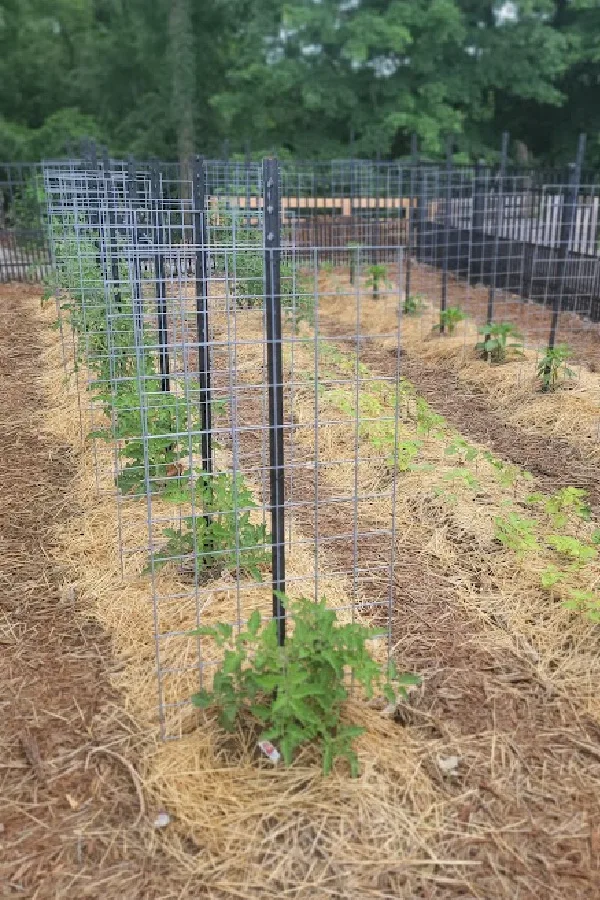If you are looking for the best way to support your tomato plants this year without spending a fortune – we have you covered today with the perfect DIY solution that can hold the biggest of plants without worry!
There is little doubt just how important it is to give your tomato plants a strong support system from the moment you plant them. As young transplants, tomatoes need protection from wind and heavy rain storms. Without it, their tender limbs can easily snap and break, heavily damaging or even killing plants.
But as they grow and mature and begin to fruit – not only do they need protection from the elements, they also need support from the sheer weight of the tomatoes ripening on the vines. Tomato plants that are full of fruit can be extremely heavy. And without good support, the limbs will easily snap – all but ruining a harvest.

Finding The Best Way To Support Tomato Plants
But as important as supporting a tomato crop can be, it can be both confusing and costly trying to find the perfect solution. Tomato cages have been around for years, but they can be expensive. Not only that, many cages simply grow out of the ground when plants get too big.
Tomato stakes are another option, but they too have issues. Not only are they hard to tie tomato plants to, they easily snap if plants get too big and heavy. And whether you use cages or stakes – the real issue is that they don’t last for long. In fact, most don’t make it past a season or two without needing to be replaced.
There are other options such as fancy new tomato towers and big square cages on the market as well, but they can be incredibly expensive. So much so that it might seem like a better choice to just buy your tomatoes at a local market to save money!
The good news? There is a simple DIY solution to support your tomatoes. One that is not just affordable, but easy to make and incredibly strong. Even better, these supports can easily last 10 years or more!
Listen In Below To Our Podcast On Making Your Own Tomato Supports With Ease!
The Best Way To Support Tomato Plants – Without Spending A Fortune!
For the last 5+ years now, we have been using a simple DIY tomato support in our test gardens at the OWG farm, and without a doubt, they have been amazing. We are still using those same supports, and they will easily last another 5+ years. Even better, as you will see below, they can be stored easily as well!
Let’s first cover how to make the supports, and then we will talk about all of the advantages of using them not just for tomato plants, but for pepper plants too. We also have a video below showing them as well.
The supports are made from two simple things. The first is a sturdy, 6′ long metal T-post that is used for fences. The second is a small section (12 to 18 inches wide) of heavy duty galvanized goat panel that attaches to it with zip ties. Both can easily be found at local farm stores.
Assembling the supports together may be the best feature of all. For us, we like to put our supports in first before planting. This allows you to tie off your young transplants to protect them right from the start. That also helps to avoid damaging growing roots if you put them in later. See: The Best Way To Plant Tomato Plants

Installing The Tomato Support
To put the support in, you start by driving the T-stake into the ground. It can be done with a hammer, a sledgehammer, or if you have a lot to do, you can use a T-fence post driver. The good news is that since they go through garden soil, they go in easy and fast. We like to drive ours in about 18 inches for good anchoring support.
Now it’s time to attach the goat panel. For this, we rest the bottom of the panel on the soil against the T-Post. Then, we simply use three zip ties to secure it. One at the bottom, one in the middle and one at the top. And your support is ready to go!
Using The Support – The Best Way To Support Tomato Plants
The smaller openings at the bottom of the goat panel are perfect for tying off young transplants. Then, the larger openings near the top allow the plant to grow freely through and up. As the plant grows, we continue to tie it off.
What really makes this “open face” design great is how easy it is to maintain and harvest plants. There is no struggling to tie off to a square or round stake. Nor is there any difficulty trying to reach through a cage to prune or pick tomatoes.
But perhaps best of all, at the end of the season, you simply snip off the zip ties, and the panels and stakes can be stored with ease. No bulky cages to fit together and take up huge amounts of space!
The Cost – The Best Way To Support Tomato Plants
Now let’s cover the cost, which is surprisingly inexpensive when you consider how strong, durable and long-lasting these DIY supports are.
The T-posts can usually be found for about $7.00 each. These are heavy duty. Avoid using the cheaper $3 posts that will bend or break. Again, when you factor in how long these supports last, the cost becomes incredibly inexpensive when compared to other options.
The goat panels come in 16′ long sections that are 42 inches high. To make individual panels, you can use bolt cutters to easily cut them down into sections. For our large tomatoes, we cut 18″ wide panels. For small tomatoes and peppers, we cut around 12 inches wide.
The panels are right around $50 each. But you can get a lot of individual pieces from each full goat panel. Depending on the width you cut, you can get anywhere from 10 to 12 pieces from a 16′ panel.
When you add in the T-Post cost with it, that means you can make these supports for about $12 to $15 each. That is way less expensive than many options – but even more – these will last a long, long time! And do they ever support tomatoes perfectly – and make harvesting a breeze!
Here is to building your own tomato supports this year – and to supporting your tomatoes with ease!
Simple Garden Life
Follow Our Facebook Page For Even More Great Tips! Simple Garden Life Facebook Page
Simple Garden Life is a website dedicated to keeping gardening fun, simple and enjoyable! We publish two new articles each week along with a new garden podcast episode every two weeks. This article may contain affiliate links.
